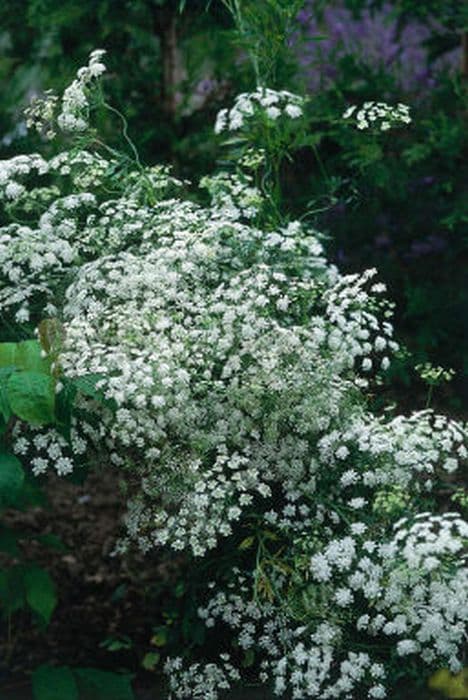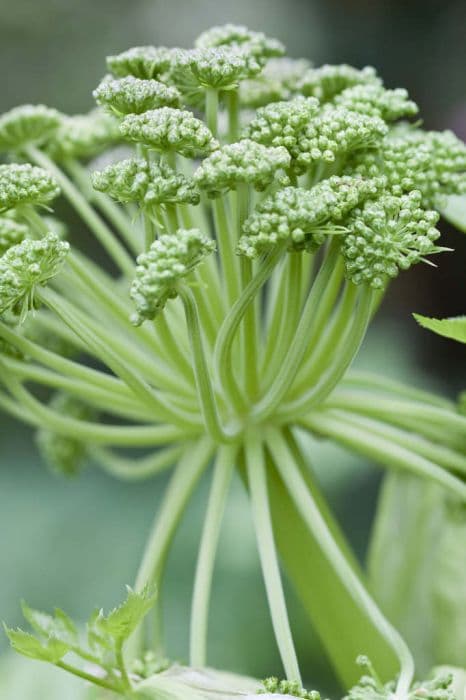Alpine Sea Holly Eryngium alpinum

ABOUT
Eryngium alpinum, commonly known as alpine sea holly, is an ornamental plant that is renowned for its striking appearance. The plant has a rosette of spiny-toothed leaves that are typically green with a slightly bluish tinge. These leaves are deeply lobed, creating a textured effect that adds to its visual interest. The most distinctive feature of the alpine sea holly is its flower head, which is a cone-shaped cluster of tiny flowers that can range in color from a metallic blue to a rich, purplish hue. These flower heads are surrounded by a ruff of spiky bracts, which can be quite showy and sometimes share the same blue or purple color as the flowers. The overall effect is a dramatic and somewhat thistle-like appearance that is quite attractive to gardeners and flower enthusiasts. The stems of this plant are stiff and branched, often taking on a similar blue-green color as the leaves. The texture of the stems and leaves combined with the bold colors of the flower heads makes alpine sea holly a popular choice for adding structural interest to a garden or as a feature in cut flower arrangements. Although resilient and relatively easy to grow in a variety of soil conditions, the alpine sea holly is particularly appreciated for its ability to thrive in dry and rocky soils, which makes it a suitable candidate for xeriscaping. It's also known for attracting pollinators such as bees and butterflies, which are drawn to its nectar-rich flowers.
About this plant
 Names
NamesFamily
Apiaceae
Synonyms
Alpine Sea Holly, Alpine Eryngo, Queen Of The Alps, Blue Star
Common names
Eryngium alpinum, Eryngium alpinum subsp. alpinum, Eryngium montanum, Eryngium paniculatum, Eryngium planum.
 Toxicity
ToxicityTo humans
Eryngium alpinum, more commonly known as alpine sea holly, is generally not considered toxic to humans. There is no well-documented evidence of toxicity or poisoning symptoms from ingesting parts of the alpine sea holly. However, as with any plant, individual allergies or sensitivities could potentially cause adverse reactions, and it is not advisable to consume any plant that is not generally recognized as edible.
To pets
Alpine sea holly (Eryngium alpinum) is not known to be toxic to pets such as cats and dogs. There are no specific symptoms of poisoning associated with this plant since it is not considered poisonous. However, ingestion of non-food items can lead to gastrointestinal upset in pets. If an animal ingests a large amount of any plant material, it is always a good idea to monitor for signs of distress or illness and consult with a veterinarian.
 Characteristics
CharacteristicsLife cycle
Perennials
Foliage type
Deciduous
Color of leaves
Green
Flower color
Blue
Height
2 feet (60 cm)
Spread
1 foot (30 cm)
Plant type
Herb
Hardiness zones
5
Native area
Europe
Benefits
 General Benefits
General Benefits- Ornamental Value: Eryngium alpinum, commonly known as Alpine Sea Holly, has distinctive spiky blue flower heads and silvery-green foliage that add unique texture and color contrasts to gardens.
- Attracts Wildlife: The plant is known to attract butterflies and other beneficial insects, enhancing biodiversity in the garden.
- Drought Tolerance: Alpine Sea Holly is well-suited for xeriscaping due to its ability to thrive in dry conditions once established, making it an ideal choice for water-wise gardens.
- Low Maintenance: Eryngium alpinum requires minimal care beyond the initial establishment period, making it a convenient option for low-maintenance landscapes.
- Cold Hardy: This plant can tolerate cold temperatures and is suitable for growing in regions with cooler climates.
- Soil Versatility: Alpine Sea Holly can grow in a variety of soil types, although it prefers well-drained soil; this adaptability makes it useful for many garden settings.
- Long Flowering Season: With a long bloom period that extends through the summer months, Eryngium alpinum provides visual interest in the garden over an extended period.
- Cut and Dried Flowers: The striking flowers and stems of the Alpine Sea Holly are well-suited for use in both fresh and dried flower arrangements.
- Deer Resistance: Deer tend to avoid Eryngium alpinum, which is beneficial for gardens in areas where deer browsing is a problem.
 Medical Properties
Medical Properties- Diuretic: Eryngium alpinum has been traditionally used to promote urine production which can aid in removing waste from the body.
- Anti-inflammatory: The plant may possess anti-inflammatory properties that can help in reducing inflammation in the body.
- Antitussive: It is sometimes used for its potential to alleviate coughs.
- Digestive aid: There are historical references to its use in helping with digestive issues, but current clinical evidence for such uses is lacking.
- Aphrodisiac: Anecdotal evidence suggests it may have been used in traditional medicine with the belief that it can stimulate sexual desire.
 Air-purifying Qualities
Air-purifying QualitiesThis plant is not specifically known for air purifying qualities.
 Other Uses
Other Uses- Eryngium alpinum, commonly known as Alpine Sea Holly, can be used in dried flower arrangements due to its striking and long-lasting blue-purple thistle-like heads.
- The roots of Alpine Sea Holly can be used in the production of certain traditional liquors and spirits in some parts of Europe, contributing a distinct flavor.
- Alpine Sea Holly is beneficial for attracting beneficial insects, such as bees and butterflies, to the garden, which is vital for pollination.
- The unique texture and color of Alpine Sea Holly's foliage and flowers make it an interesting candidate for botanical art and photography projects.
- The plant has been historically used as a rennet substitute in cheese making because of certain enzymes present in its tissues.
- Alpine Sea Holly can be used in a rock garden for aesthetic purposes, providing a distinct shape and color contrast to the stones.
- Due to its robustness, Alpine Sea Holly can be utilized in coastal landscapes where it can tolerate salty winds and soil.
- Its stiff, vertical growth habit allows Alpine Sea Holly to be used as a natural fence or border in garden design.
- The dried seed heads of Alpine Sea Holly can be used in crafting, such as in making natural jewelry or as part of a wreath composition.
- An eco-friendly dye can be derived from the intense blue flowers of Alpine Sea Holly for use in fabric and paper dyeing crafts.
Interesting Facts
 Feng Shui
Feng ShuiThe Sea Holly is not used in Feng Shui practice.
 Zodiac Sign Compitability
Zodiac Sign CompitabilityThe Sea Holly is not used in astrology practice.
 Plant Symbolism
Plant Symbolism- Independence - Eryngium alpinum, commonly known as Alpine Sea Holly, has a unique and spiky appearance, symbolizing a fierce independence and ability to stand out in any situation.
- Protection - Its thistle-like shape and texture suggest a protective quality, representing the idea of guarding oneself or others from harm.
- Attraction - With its striking blue color and intricate design, Alpine Sea Holly is also associated with attraction and can symbolize a magnetic charm or allure.
- Endurance - The plant's hardiness and ability to grow in challenging conditions are emblematic of strength and endurance, making it a symbol of resilience.
 Water
WaterAlpine sea holly, also known as Eryngium alpinum, should be watered thoroughly, ensuring that the soil is moist but well-drained. It generally requires about 1 inch of water per week, whether from rainfall or manual watering. During the growing season, especially in hotter, drier climates, you may have to water the plant more frequently to maintain consistent soil moisture. However, in cooler climates or during periods of rainfall, water consumption will be less. It's essential not to overwater as this can lead to root rot. Always check the top inch of soil for dryness before watering again.
 Light
LightAlpine sea holly thrives in full sun conditions, requiring at least six hours of direct sunlight each day to flourish. The best spot for this plant would be an open area where it receives ample sun throughout the day, such as a south-facing garden bed. Avoid planting it in areas that receive too much shade as this can impede its growth and flower production.
 Temperature
TemperatureAlpine sea holly prefers cooler temperatures but is quite hardy and can withstand a range of conditions. It can survive in temperatures as low as 0 degrees Fahrenheit and as high as around 85 degrees Fahrenheit. The ideal temperature for Eryngium alpinum to thrive is between 60 and 70 degrees Fahrenheit during its active growth period.
 Pruning
PruningAlpine sea holly should be pruned to remove spent flower stems and encourage new growth. Deadheading, or cutting off the faded flowers, can be done as soon as they wither to maintain visual appeal and prevent self-seeding if not desired. The best time for pruning is late winter or early spring, before new growth begins. This plant does not require extensive pruning, just tidying up and removal of dead or damaged tissue.
 Cleaning
CleaningAs needed
 Soil
SoilThe Queen of the Alps thrives in a well-drained soil mix, preferably with a mix of loam, peat, and sharp sand to mimic its native alpine conditions. The ideal pH for Eryngium alpinum ranges from slightly acidic to neutral (pH 6.0-7.0).
 Repotting
RepottingQueen of the Alps typically does not need to be repotted often, as it can thrive in the same pot for several years. Repot every 3-4 years to refresh the soil and to accommodate any significant growth.
 Humidity & Misting
Humidity & MistingThe Queen of the Alps is tolerant of a wide range of humidity levels but prefers conditions that are on the drier side, consistent with its native alpine habitat.
 Suitable locations
Suitable locationsIndoor
Ensure full sun, well-draining soil, and cooler temperatures for Queen of the Alps.
Outdoor
Plant in full sun, well-draining soil, and protect from excessive winter wetness.
Hardiness zone
4-8 USDA
 Life cycle
Life cycleThe life of Eryngium alpinum, commonly known as Alpine sea holly, begins with seed germination, which requires cold stratification to break dormancy. Once germinated in spring, seedlings establish a rosette of spiny, heart-shaped leaves at ground level. As the plant matures, it develops a sturdy, erect stem and a more extensive root system. During the summer of its second or third year, Alpine sea holly blooms, producing striking blue or purple flower heads surrounded by spiky bracts. After pollination, often by various insects attracted to the flower's nectar, seeds develop and are dispersed in late summer or fall. The plant may die after seed set (being monocarpic), or continue to live and bloom for several years (being polycarpic), depending on environmental conditions and specific plant characteristics.
 Propogation
PropogationPropogation time
Spring to Summer
The most popular method of propagation for Eryngium alpinum, commonly known as Alpine sea holly, is by seed. The best time to sow seeds is in spring, after the risk of frost has passed, usually between March and May in most temperate climates. To propagate, seeds should be sown in well-draining soil at a depth of about 1/4 inch (6 millimeters). The soil should be kept moist but not waterlogged. Germination can be slow and erratic, sometimes taking several weeks. Once seedlings have developed a couple of true leaves and are large enough to handle, they can be transplanted into individual pots or their final position in the garden, ensuring they are spaced around 12 to 18 inches (30 to 45 centimeters) apart to accommodate their mature size.









